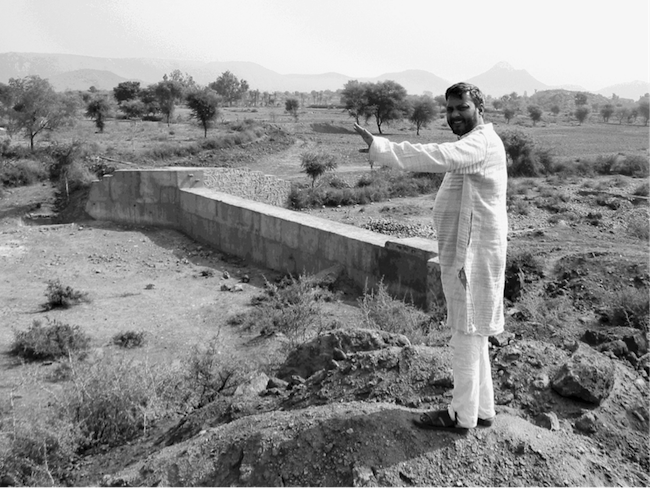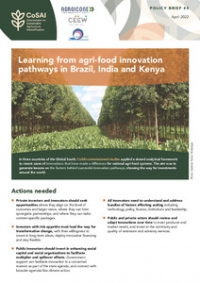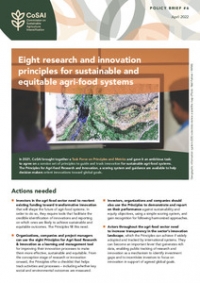Rain-fed agriculture occupies more than 75 percent of the world’s cropland. The prevalence of these farms provides a compelling case for why we must use rainfall more efficiently to improve agricultural productivity and take some of the guesswork out of climate change–driven variability in rainfall patterns.
 A rainwater-harvesting structure in the Indian countryside.
A rainwater-harvesting structure in the Indian countryside.Photo: International Rivers on Flickr
Rainwater harvesting — a time-honored tradition nearly as old as humanity itself — can help us navigate through some of the precipitation uncertainties we will face in the 21st century. With its low-tech approach, flexibility of design, and near-universal applicability, rainwater harvesting remains popular, and is practiced in places as diverse as Brasil, the United States, Sierra Leone, Ethiopia, and India, to name only a few.
Meanwhile, additional help is on the way. “Old techniques have now been modified with new knowledge and supplemented with modern technology” to further improve rainwater harvesting, Anil Jain, a government engineer and water specialist in Rajasthan, India, recently told the Agriculture and Ecosystems Blog.
Updating an age-old practice
Integrated water harvesting
One of the most exciting innovations is what American rainwater-harvesting expert Brad Lancaster describes as an “integrated water harvesting system” that “harvests sun, wind, and shade, as well as rain.” According to Lancaster, such a setup provides multiple benefits to farmers.
In the arid southwestern United States, he says, “crops grown with a sun screen to the west — shading crops to the east from the hot afternoon sun — use 25-50% less water than those crops without a western sun screen.” Lancaster says if “hardy, native, food-bearing perennial trees and shrubs” are planted to provide the necessary shade, they can “reduce the effect of drying winds” on crops, limit soil erosion, and enhance the soil’s ability to retain rainwater.
Efficient storage
Another innovation involves more efficient storage, experts say. In arid and semi-arid climates where solar radiation is intense and evaporation rates are high, storage in surface reservoirs can result in large-scale water loss.
In response, a growing number of communities across India — where nearly 100 million hectares of about 180 million hectares of total arable land remain rain-fed — are injecting harvested rainwater into underground aquifers to bolster local water security, says Jain. “Groundwater recharge is gradually gaining importance,” he observes, because “the recharged aquifer can be a great source for irrigation water in the long run without the risk of evaporation.”
Underground storage may not be an option for farmers on subsistence-size plots, however. In these circumstances, Ethiopian rainwater harvesting expert Ato Hune Nega points out rainwater can also be stored by pooling it deliberately at strategic surface locations within an agricultural plot — with the soil itself essentially serving as a water bank.
This approach not only boosts crop productivity by “improving soil moisture” and “protecting [against] soil erosion,” he says, but it also assists in recharging the groundwater supply. To further enhance soil’s ability to hold precipitation, experts recommend using surface mulch to lock in moisture and mitigate the impact of extreme air temperatures.
Power in numbers: Overcoming financial hurdles
Rainwater harvesting for irrigation has some innate cost-savings built-in; it does not need to be treated before use on crops, for example. Nevertheless, when it comes to prospects for scaling-up rainwater harvesting on wider level, funding can be an issue; covering initial investments in infrastructure, personnel training, and ongoing maintenance costs takes commitment and cash.
In an ideal world, says Tania Arroyo-Zambrano with the National Autonomous University of Mexico’s Ecotechnologies Unit, “rainwater harvesting could easily be available for all with some financing provided either by governments or NGOs.” In practice, however, such investment can prove elusive.
According to Jain and Nega, agricultural cooperatives could help share the costs of new infrastructure. If small-scale farmers entered into such groupings, it “would reduce per capita cost” by allowing them to “pool resources and rainwater harvesting infrastructure,” Jain says, “yielding better results” as a collective than as individuals.
Nega suggests farmers could organize themselves into groups of no more than 10 members, with costs of “locally available construction materials” for infrastructure covered by the group and costs of materials brought in from elsewhere covered via bank loans. Such “entrepreneurship development,” says Jain, could make investment in rainwater harvesting less of a financial risk for any one farmer.
What other approaches might be considered to reduce financial barriers for parties interested in rainwater harvesting?
Concerns for consideration
Improved storage options and integrated harvesting schemes are a start, but what corresponding changes in small-scale agricultural practices must take place to most effectively utilize captured rainwater?
“We must fit the crop to the climate,” insists Lancaster. With long-term projections forecasting declining precipitation levels this century, “increased use of less water-intensive crops” will be essential, says Jain.
Meanwhile, rainwater stored at the surface could also potentially exacerbate public health risks in some parts of the world because reservoirs, ponds, or standing pools of collected rainwater might be ideal “sites for malarial mosquitos,” according to Nega. However, he adds, “preventive measures” — such as covering bodies of stored water and “protecting the water from direct sunshine” — could be implemented to mitigate against mosquito breeding.
Spreading the word
If implemented intelligently and in accordance with local climate and geographic conditions, rainwater harvesting can serve as a powerful tool to increase reliable access to water. But despite the fact that it has been practiced for millennia throughout the world, rainwater harvesting is still unknown to many communities.
“I would recommend financing education and capacity building,” says Jain. Echoing that sentiment, Lancaster adds that only once “everyone understands how the systems work — what to do, what not to do, and why — can people take informed action.”















Comments
Very nice Russel. I would recommend a more exhaustive study on traditional water management practices in Rajasthan, India. A lot can be learnt from the traditional wisdom so as to arrive at less cost intensive and people friendly solutions for wise water management.
Crowdfunding only works when the crowd funds! See my Rainwater Crowdfunding Campaign!
Seems to be an obvious statement doesn't it? Just because you have thousands of friends, likes and followers does not translate into a successful campaign. The crowd has to be engaged to have a campaign produce the intended results. If the crowd is not engaged, stimulated to action, they don't fund and the otherwise great campaign fails.
Two weeks of the campaign are gone already and we only have six weeks to go. Please visit my campaign make your choice of rewards and forward it to EVERYONE you know to give them the opportunity to select a great reward.
https://www.indiegogo.com/projects/choose-rain-takes-the-evil-out-of-bot...
Thank you!
I hope this kind of idea will work for that kind of situation. :)
Agreed, if use the rainwater effectively we can increase the agriculture percentage.Its important to store the rainwater.
I workin an area plagued by rainfall variability and cyclones in monsoons. The dry spells in cropping season have increased. We use indigenous seeds. No resources for large scale water harvesting structures. The soil is black cotton and agri is on undulating mid and up lands. What would you recommend for water harvesting. Would appreciate any help